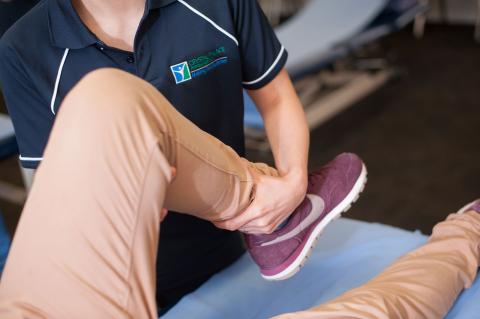Work-related musculoskeletal disorders (MSDs) present a serious, ongoing threat to the health and wellbeing of all physio staff, and the risks are particularly high for new graduates

Crucial steps to prevent and report MSDs
Your employer or clinical placement manager should take action to protect you from the risks of MSDs being caused or made worse by work.
It is important that you as a physiotherapist or physio student take steps to limit your own risk of injury, or of making an existing injury worse, by getting involved in the process of assessing and managing the risks.
It is also crucial that you report any injuries, pain symptoms or near misses.
On this page:
What your employer should do
Your employer has responsibilities to reduce the risk of injury to staff, students on clinical placement and people using care services by:
- avoiding those manual handling tasks that could result in injury
- assessing the risks from moving and handling that cannot be avoided
- putting measures in place to reduce the risk
The Health and Safety Executive provides specific guidance for employers in the health sector as it is a high-risk sector for work-related MSDs. In particular, it gives advice on safe moving and handling of patients and equipment. The CSP guidance on manual handling in physiotherapy is an essential resource for you on this subject.
The NHS Staff Council provides detailed guidance on risk management for MSDs in the health services, which involves a process of identifying, assessing and controlling risk and reviewing the controls that have been put in place.
Your risk assessment
Become a CSP safety rep
If there isn't one in your workplace, consider becoming a safety rep.
When you commence your employment as a physio or your clinical placement, your manager or supervisor should conduct or arranged for a manual handling risk assessment of your post/placement. This should include an assessment of your training needs and personal requirements.
If this has not taken place, talk to your safety rep – or, if you are a student on clinical placement, your course tutor.
If possible, ensure that your risk assessor is 'competent’ by checking their credentials.
If the risk assessor makes recommendations, it is important that your employer implements them. If this is not happening, talk to your safety rep – or, if you are a student, your course tutor.
Manual handling training and advice

As well as having an initial risk assessment, you should have an ongoing training programme that will continue to develop your skills, knowledge and experience of manual handling as part of your CPD.
Ensure you attend this, and provide feedback if it does not meet your needs.
Consider whether you can acknowledge your own personal and professional limitations in manual handling. If not, why not? Useful professional advice is provided to members in chapter 4 of the CSP guidance on manual handling in physiotherapy.
Do you have access to qualified Back Care Advisors who can help you with any issues in your physiotherapeutic practice or problems with manual handling? Ask your line manager or clinical lead if you are unsure.
Also check whether there is appropriate manual handling equipment for your needs and whether it is adequately maintained and stored in a secure and accessible place.
If you are unsure or concerned, speak to your safety rep – or, if you are a student, your course tutor.
Reporting incidents and symptoms
Ensure you are aware of the reporting system in your workplace for accidents, injuries and near misses.
Report injuries and any pain you are experiencing, as well as near misses. Make and keep a copy of your incident form.
If you do not already know, find out whether you have direct access to your employer’s occupational health services – or, if you are a student, those provided by your higher education institution. Know what the process is for seeking a referral.
If you are unsure or concerned about any of this, speak to your safety rep – or, if you are a student, your course tutor.
Key dos and don'ts
Do:
- attend your manual handling training and provide feedback if it does not meet your needs
- if you can, raise any concerns with colleagues if you think their practices are putting you or themselves at risk – seek advice from your accredited safety rep at work
- report any injuries, pain symptoms or and near misses and keep a copy of your incident form
- recognise your own limits and take regular breaks
Don't
Don't be complacent about your safety. If you know there is an unsafe manual handling culture in your workplace, talk to others in your workplace and reflect on why and the consequences. Lead by example in showing safe best practice, particularly when working with new graduates.
